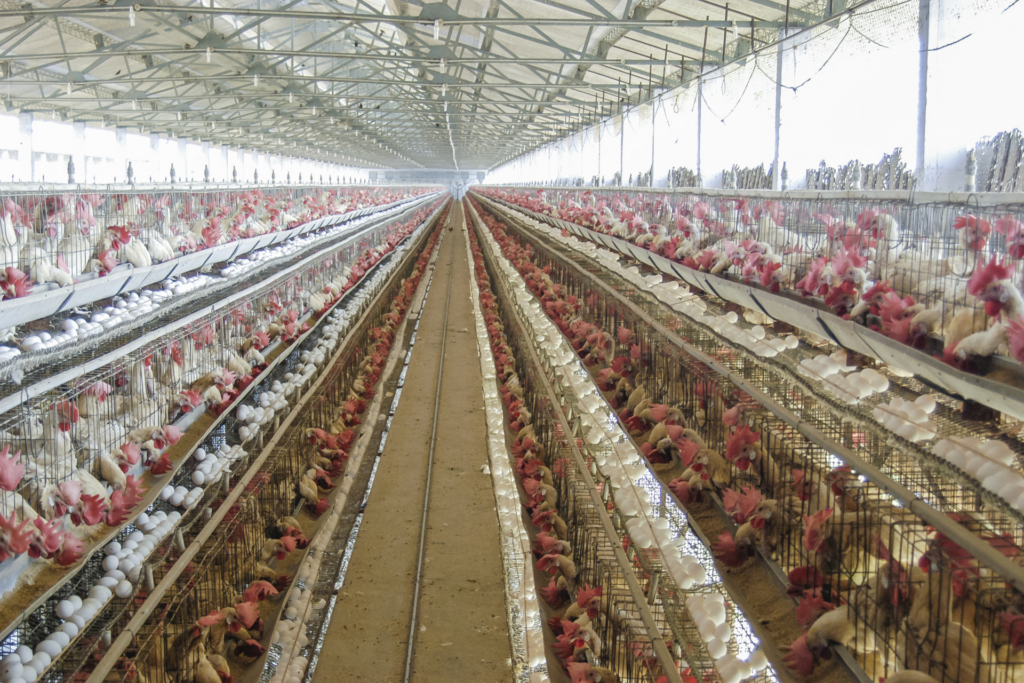Once ‘defanged,’ H5N1 bird flu is gaining teeth again
By Lynn C. Klotz | June 8, 2023
 A poultry farm in India. Credit: Matthew T Rader via Wikimedia Commons. CC BY-SA.
A poultry farm in India. Credit: Matthew T Rader via Wikimedia Commons. CC BY-SA.
We thought we were finished with deadly highly pathogenic avian influenza (HPAI). Between 2003 and 2023, the avian H5N1 virus killed over 50 percent of those diagnosed with infection (458 deaths in 874 cases). Fortunately, the virus was rarely transmissible among humans, and since around 2015, human H5N1 cases and fatalities have almost disappeared, as the strains from nature that have appeared in poultry markets were no longer deadly. They were so to speak “defanged,” which was a relief to those who had close contact with poultry.
We were in a good place. Not only was the virus no longer killing scores of people, it wasn’t transmissible through the air in mammals, one of the primary ways influenza spreads. (In birds, the flu spreads through close contact with infectious secretions, like saliva or through contact with contaminated surfaces.) But for years, scientists have warned that an H5N1 pandemic could be looming. The authors of a 2012 study, for example, found that of five changes to H5N1 that were thought to make the virus transmissible among ferrets, two were already common in nature. Just three more changes and H5NI, a virus that essentially only infects people with close contact to birds, could become a pandemic threat.
Now we are seeing the prolific spread of avian H5N1. Writing this year in The Lancet Infectious Diseases, scientists noted that for “the first time, in 2021, the virus remained present year-round in wild birds in Europe, spread to North America, and spread onwards to South America in 2022, where it is still expanding southward.” So far, H5N1 has caused the deaths of 100 million poultry birds in the United States and Europe. And worse still, repeated outbreaks among mammals could allow the virus to mutate and begin to pose a greater threat to humans, especially given worrying signs that mammals are already spreading the virus through the air. H5N1 has infected some 30 mammalian species and has sparked outbreaks and deaths in seals in North America and farmed mink in Spain. “It’s certainly plausible that those animals are spreading virus by droplet or aerosol to each other,” Tufts University veterinarian Jonathan Runstadler said of the seal outbreak in an interview with the Journal of the American Medical Association. “They’re having interactions at close range, and a lot of vocalizations…. But there’s other routes in that scenario that we can’t rule out.”
H5N1 isn’t at this point spreading among people efficiently, but clearly the virus is different than it was just a few short years ago. According to the World Health Organization (WHO), human H5N1 cases dropped to zero by 2018. Those numbers, while still low, are no longer zero. So far this year there has been one death in Cambodia. The authors of the 2021 Lancet paper wrote, “The global spread of H5 HPAI is cause for concern, given the high mortality in wild birds and poultry, but also because of numerous reported cases in mammals, including some in humans.”
Fortunately, things can be done to lessen the risk of an H5N1 pandemic happening, or, if it happens, to reduce its likely toll.
In modern, large-scale agriculture, farm animals are often densely confined to small areas, the perfect conditions for the rapid spread of pathogens like the H5N1 virus. The Lancet authors advocate for greater disease surveillance of pig, poultry, and mink operations and for reducing the size of poultry farms, vaccinating chickens, and improving biosecurity regulations.
Inoculating farm animals with traditional vaccines should be possible and has been done in the past. In 2013, an avian influenza known as H7N9 began spreading in poultry in China. After a particularly scary epidemic in 2016 and 2017, when close to 800 people were infected and nearly 300 died, China implemented an aggressive campaign to vaccinate poultry. Human cases dropped to near zero following the campaign. “[t]he Chinese began a very aggressive and comprehensive program to vaccinate poultry against H7N9,” public health expert Michael Osterholm told Infectious Disease News in 2018. “That is by far the most likely explanation for what happened, but even there we can’t be certain.”
In the United States, where 58 million birds have been killed by H5N1 or culled as a result of an infection in a flock, the government is assessing vaccines and vaccination strategies. It’s a complicated issue because vaccines may not eradicate the disease and infected birds could still shed the virus. Or the vaccine could lose effectiveness as the virus mutates. Many countries do not accept imports of vaccinated birds, under the assumption that they could still carry avian influenza. Several countries, including China and Egypt, have available vaccines, and, according to CNN, some countries are vaccinating flocks.
Another important tool in preparing for an H5N1 pandemic would be human vaccines. It is unclear when the H5N1 virus, transmissible and deadly to birds and mammals, will infect humans in large numbers, so the commercial incentive may not yet exist for Moderna, Pfizer, and other companies to begin creating vaccines. Both those makers of the mRNA COVID vaccines are developing influenza vaccines using the new method, but the vaccines do not address highly pathogenic, transmissible H5N1 avian flu virus. Luckily, an mRNA vaccine against this new threat could be developed in a few weeks, just as COVID vaccines the companies make can be updated relatively quickly. A team of authors mainly from the University of Pennsylvania have been developing an mRNA vaccine for the strain of H5N1 viruses currently circulating among birds. They found the vaccine strongly protects mice and ferrets. Likewise, scientists are working to develop a “universal” influenza vaccine, which could protect against all influenza strains.
In the meantime, should a pandemic appear imminent, donning N95 or KN95 masks in the same situations in which they were worn to protect against COVID-19 might provide breathing room for mRNA vaccines to be developed and distributed.
Experts agree that an H5N1 threat to humans is not around the corner. For instance, Caitlin Rivers, an epidemiologist at the Johns Hopkins Center for Health Security, told Scientific American, “I’m keeping a close eye on it as an expert, but as a member of the community, as a parent and someone who [has been] recently experiencing the COVID-19 pandemic, I’m not worried about this right now.” Likewise, Osterholm, of the University of Minnesota’s Center for Infectious Disease Research and Policy, told the publication that he doesn’t think H5NI is an immediate risk for humans.
If it does become a human health issue, given its high case fatality rate so far, H5N1 could become a major global threat. The world needs to prepare by developing vaccines now. If companies are unwilling to take the financial risk of such early efforts, governments should provide the funding.
Together, we make the world safer.
The Bulletin elevates expert voices above the noise. But as an independent nonprofit organization, our operations depend on the support of readers like you. Help us continue to deliver quality journalism that holds leaders accountable. Your support of our work at any level is important. In return, we promise our coverage will be understandable, influential, vigilant, solution-oriented, and fair-minded. Together we can make a difference.
Keywords: H5N1, pandemic
Topics: Biosecurity















The host range now includes more than 50 mammalian species:
https://www.fao.org/animal-health/situation-updates/global-aiv-with-zoonotic-potential/bird-species-affected-by-h5nx-hpai/en
Also BARDA does a great job incentivizing smaller innovative companies like SAB, Cidara or VIR to develop broad solutions related to antibodies.
The study from the University of Pennsylvania quoted in this article shows why there is little motivation to study H5N1 vaccines beyond pre-clinical research: The effectiveness depends very much on the specific strain. Meanwhile Moderna has completed a phase 3 study for an mRNA influenza vaccine, which will probably be available next year to protect from seasonal influenza A and B.